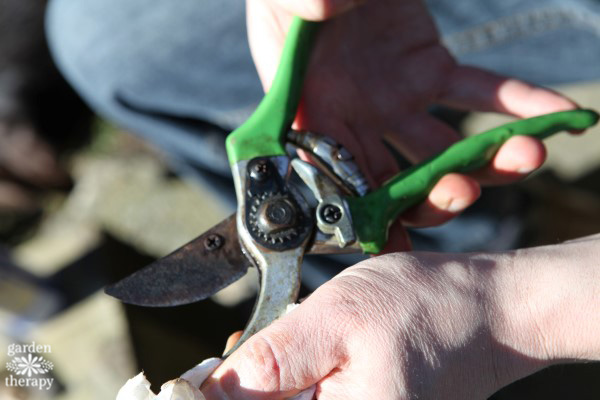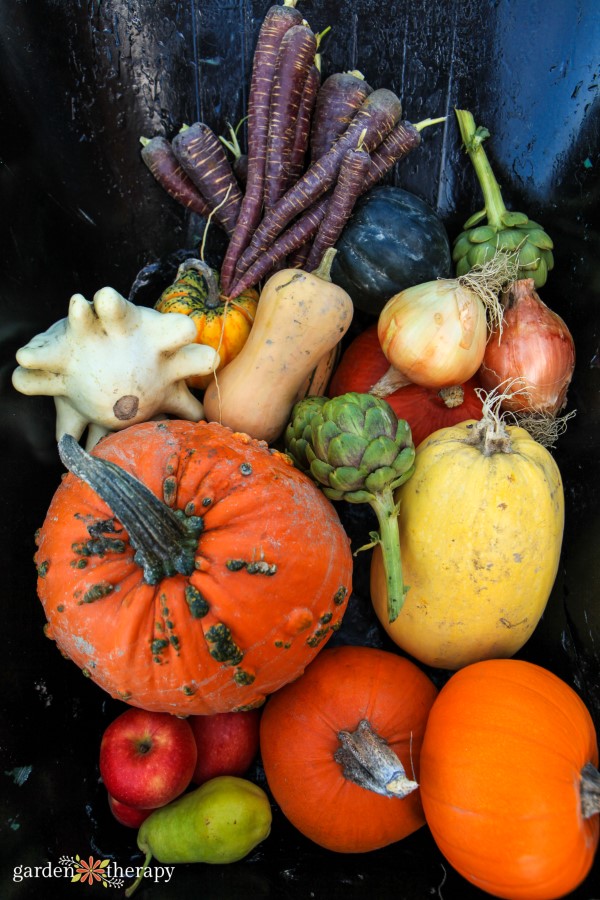Let’s not Konmari our backyards. It doesn’t need to be a beautifully curated and perfect space before we settle in for the winter. No, let’s make fall gardening the relaxing activity it’s supposed to be! Here’s how to make your fall garden tasks easier to tackle when you’re feeling overwhelmed.

If you were to pop into my home, you’d see the graveyard of half-completed to-do lists. A post-it note here, a scribbled napkin there, and perhaps even the remnants of a half-finished task.
Some have most things crossed off, some just a couple. I’m busy, I’m overwhelmed, and that’s okay.
It happens to us all, and having a long list of to-dos can get very overwhelming very quickly.
When it comes to the fall garden, I always make a checklist (like this one here). There’s a lot of work that goes into putting the garden to rest while still trying to squeeze out as much of the remaining sun and warmth as possible.
Us gardeners know that spring and fall are truly the busiest gardening months, not the summer when the plants are busy doing their own thing.
While checklists and to-do lists are very helpful for some, including my past self, I’m trying a different approach this year, and I wanted to share it with you.
This post will cover…


Making Fall Gardening Tasks Attainable
Rather than make a big list of things you need to do in the garden and set out a day or even a week to do them, give yourself a little grace.
My philosophy to gardening has always been to do what you can, and don’t fuss about it. Gardening should never be a stressful activity where you’re running ahead with a rake in one hand trying to get the leaves and a hose in the other spraying down your gardening pots.
You’ve got all the time in the world!
Start with five minutes a day, or ten minutes a day, or even half an hour twice a week. Whatever time you think you have to dedicate before getting stressed about everything else you need to do in your life should be the starting point.
Set the minimum time you want to spend in the garden and make it a daily ritual. Maybe skipping a rainy day or two (I won’t tell, I promise).
For instance, your first “task” might be to deal with the compost bin. On the first day, you might turn your compost and see if it’s ready. On the third day, you could empty it and put a layer down on your gardening bed. The fourth day, you could give your compost bin a rinse, and voila! You’re done.


Go With the Momentum
Getting out in the garden for just five minutes a day is a good start. Often, starting is the hardest part. But once you’ve started, you may find yourself with more momentum than you initially thought.
This is why I always tell Kiddo that the very first thing to put on a to-do list is “make a list.” Because you instantly get to check it off, and you feel so good. That rush of dopamine propels you into doing the next thing.
Prioritize Your Tasks
Some tasks you must do, like putting away your outdoor furniture and cleaning out your water feature, while some tasks you could get away with not doing, like dividing perennials or recycling plant pots.
Make sure to get to those must-dos first so you know that if you run out of time and energy for the others, it’s not the end of the world.
Work From Front to Back
If you look out at your garden and all you see are tasks and too much to do, you might need a different approach. In this case, I like to work from the back of my garden to the front, the left to the right, or vice versa. Just start with one spot and slowly work your way over until the garden is more manageable.


Fall Gardening Tasks to Consider
You can definitely still make a general list, or break up larger tasks into smaller ones. However you want to do it, you’re welcome to do it.
This year, we’re coming from a place of forgiveness and peacefulness. There’s no pressure to make your yard look perfect and to get everything done before the first frost touches ground.
Below are some tasks I usually like to complete in the garden. Use them as inspiration for making your own list, but remember, you only do what you can. Your garden will be okay, regardless!
Plastic Nursery Pots
If you’re like me, you might have a small mountain of plastic nursery pots hiding away somewhere in your garden.
If they’re collected cobwebs and standing water and are overall icky and not something you want to even touch, it’s time to get rid of them. Recycle them the next garbage day in your city allows them.
More on recycling plant pots in this post.
Yes, it’s nice to keep a few for seed starting. But recycle what you don’t need!


Clean Your Pots
For all those pots you’ve decided to keep, it’s time to give them a clean. You can give them a quick clean with the garden hose, or wash them with dish soap and a sponge for a more thorough clean (I like to do this with my terracotta).
Stack them neatly and safely, somewhere where they’re ideally covered and protected from nesting animals and the cold from potentially cracking them.


Container Plants
If you have plants that will be staying in their containers for the winter, AKA your perennials, you’ll want to give them some TLC. Everyone needs a helping hand to get through the winter, let’s be real!
Drain any water you might have from self-watering pots. But keep any tender plants undercover or tuck them away in the garage.
I also like to still get my creative itch out in the fall, and containers are a great way to do this. You can decorate hardy planters with fall annuals and some evergreens for some seasonal and festive gardening.


Discard Old Seeds and Bulbs
I know you look at that crusty, dusty bag of bulbs you forgot to plant and think, “Maybe I can still get them in the ground next year.”
It’s time to let go. Ditch the guilt, and compost those old bulbs and get rid of those seeds. Try again next year with some new summer bulbs or plant some spring bulbs right now!
You can always try and sow some seeds now and see what happens. You never know, you could get some beautiful flowers next spring. Or not. But it doesn’t really matter!
Clean Out the Garden Shed
I bet you there are either dried-up grass clippings, little pieces of caked mud, mouse droppings, or cobwebs hanging out in your garden shed.
Give the floor a quick sweep. If you’re feeling up to it, organize and purge as necessary.


Soil Prep
Your garden beds are easy peasy. I leave all the seed heads, dead foliage, and dying plants to return to the earth. Don’t worry about making everything look pristine.
The only thing I do with my garden beds is add a layer of compost. I then cover it with leaves. I’m a firm believer of leave the leaves, instead leaving them to be chopped up in the lawn mower or pushed into the gardening beds to become natural mulch and feed the soil.


Prepare Your Water Features for Winter
If you have water features in your garden, such as a pond or fountain, you will want to prepare them for winter. Otherwise, they might break or be damaged the following spring.
Follow these instructions on what to do with your water features.
Clean Your Garden Tools
Now, I know I’m supposed to sanitize my pruners whenever I clip something new, but that doesn’t always happen. And there maybe a little rust on them too. Just maybe.
The end of the summer is a good time to go through your gardening tools and give them a good clean. I list out my tool care in this post if you want to check it out.


Move Furniture Undercover
Outdoor furniture goes through A LOT, and the winter certainly isn’t its friend. Most outdoor furniture has such a short lifespan (it’s actually quite a big pet peeve of mine), and we want to prolong its life as long as possible by tucking it away for the winter.
Before storing it for the winter, I like to make repairs to any broken pieces, wash any fabrics, and sand and stain wood (which can be a big project).


Divide Perennials
If you’re taking a look at your garden and things are starting to look a little overgrown, it might be time to divide some of your perennials. And fall is the perfect time to do so!
Generally, you need to divide your perennials every three to five years. I have a whole post dedicated to teaching you how to divide perennials.
Plant Shrubs and Trees
What if I told you that fall is the perfect time to make design changes to the garden? Yes, I’m giving you permission to go to the garden centre and buy some new plants. And better yet, all the plants are on discount.
I have some design suggestions you can follow in this post. You want to get the perennials in the ground ideally six weeks before the first big frost to give the plants time to settle in before the winter.
Trim Hedges
I’ve already started to notice the fallen soldiers of hedge trimmings when I go for a walk in my neighbourhood. Fall is also a great time to trim your hedges. This will give them the perfect shape for all winter.


Buy New Garden Items
I like to look on Facebook Marketplace or in free groups for second-hand items I might need, whether that’s replacing some broken tools or something that’s been on the wishlist for a while.
A lot of people don’t want to store their gardening materials for the winter, so they will give away or inexpensively sell their outdoor furniture, water features, pots, etc.
And you can be there to scoop them up!


Harvest Your Food
You’ve spent all spring and summer carefully tending to your veggies, berries, herbs, and fruits, so don’t let them go to waste. See if you can dedicate a day to storing your food. This can include canning, drying, or preserving them.
If I’m strapped for time, I like to freeze what I can and save it for a day when I’m not so busy and can do something with it.


I hope this got the juices flowing. So make a fall gardening list…or don’t! Just try to enjoy your time, because even though the days may be getting shorter ever so slowly, it’s a great time to still be out enjoying the garden.

